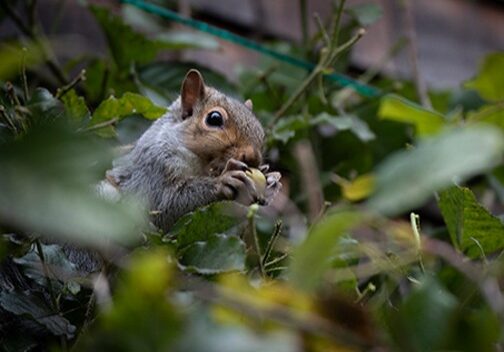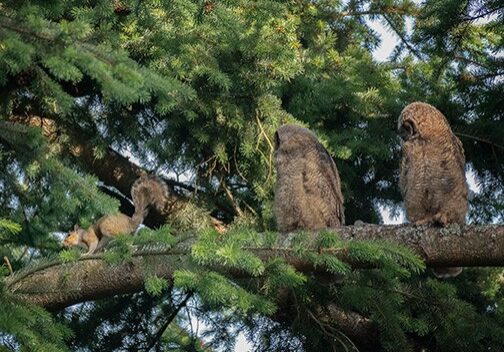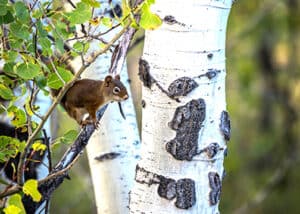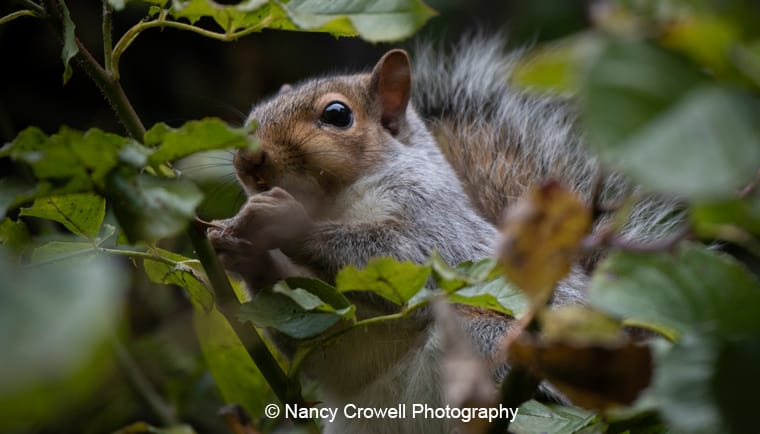Northwest Tree Squirrels
By Kathy Wolfe, Skagit County WSU Extension Master Gardener
Squirrel ˈskwə-rəl
noun:
- a: Lively, adorable, cavorting, wide-eyed, bush-tailed acrobat whose antics and gyrations are a joy to watch.b: Destroyer of flower beds and home irrigation lines, raider of bird feeders, disease-carrying rodent full of fleas and ticks.
Here in lies the ambiguity of the squirrel. At times they can be the most entertaining creatures in our yard and at other times they can be very destructive to our landscapes, wildlife, and home structures.
Identification:
Washington has four native species of tree squirrels.

The Douglas squirrel (Tamiasciurus douglasii) measures 10 – 14 inches in length, including its tail, with a reddish or brownish gray back and an orange or yellowish belly. Douglas squirrels are usually found in cedar, pine, and fir forests in western Washington and the Cascade Mountains.
The Red squirrel (Tamiasciurus hudsonicus) is approximately the same size as the Douglas squirrel and lives in semi-open woods and coniferous forests in northeast Washington. Their rusty-red coat and white or grayish-white bellies help identify them.
The Western Gray squirrel (Sciurus griseus) is a larger animal measuring between 18 – 24 inches long. It has a gray upper body and creamy undercoat featuring a long, bushy tail with white edges. Western Gray squirrels are found in western and central Washington in low-elevation oak and conifer woods.
The Northern Flying squirrel (Glaucomys sabrinus) is smaller than the others, measuring 10 – 12 inches in total length. It can have a dark gray or brown body with a creamy underbelly. The large, dark eyes are another key to identifying it, as is the wide and flat tail. Seldom seen, they glide through the trees at night.
In addition to our native squirrels, the Eastern Gray squirrel and Eastern Fox squirrel were introduced in Washington in the early 1900s. They are the most common tree squirrels in urban areas and are often spotted in parks, campuses, and residential areas. The Eastern Gray squirrel, gray with a reddish wash in summer with a whitish belly, is about 20 inches long, half of which is its prominent, bushy tail. The Eastern Fox squirrel is approximately 22 inches long which includes a large tail measuring 9 - 10 inches. Its coloration is usually dark gray with a reddish cast and orange to deep buff underpinning. The fur color of both introduced squirrels can vary widely and sometimes they can be almost entirely black.


Eating habits:
Squirrels can be seen eating acorns, seeds, tree buds, and berries as well as plant material and twigs. Occasionally they will eat parts of a bird’s nest-- the eggs, or baby chicks. Insects and fungi are also a part of their diet. They store their food in hollow stumps, abandoned burrows, and any hidey-hole they can find - including exhaust pipes, under flower pots and in unused cars. In the fall when Douglas squirrels and Red squirrels are harvesting and storing food for winter, you may see debris under oak, maple, nut trees, and conifers which indicates that the animals have been breaking off seed and nut clusters and dropping them to the ground where they harvest them for a meal or store for later use. You might find a pile of cone scales under a tree where squirrels have harvested the seeds of the cone.
Nesting, mating, and lifestyle habits:
Hollow cavities are also used for nesting. Leaves, twigs, shredded bark, moss, insulation and other soft materials are used to structure their nests. When hollow cavities are not available, spherical or cup-shaped nests are built in trees, bird nesting boxes or even attics. In cold weather, red squirrels may nest underground, often near where they have stored their food. Urban squirrels generally nest in buildings or other structures.
Mating occurs in early winter to late spring, with one litter of two to four babies produced in March through June. Some species may have a second litter in August or September.
Although squirrels are relatively safe when up in trees, they are vulnerable on the ground to hawks, owls, cats, dogs, coyotes, and bobcats. Vehicles, disease, and starvation are also killers. Squirrels can live for three to five years, but most die within their first year.
Squirrels are most active from dawn to dusk. They do not hibernate in winter but remain in their nests if the weather is stormy or cold.
If you watch squirrels running up and down a tree, you might notice their speed. Their double-jointed hind legs propel them forward quickly. They also use their very sharp front claws to grip and climb.
Listen to their distinctive call. A Red or Douglas squirrel whose territory is being trespassed may produce a rapid tsik tsik tsik. The Eastern gray squirrel flicks its tail while making a que, que, que, que sound.

Managing Human/Squirrel Interaction:
Tree squirrels can be destructive to bird feeders and bulb plantings among other things. Should a squirrel decide to take up residence in your attic or down your chimney, you won’t be pleased. To limit this, look around your buildings and eliminate access through dryer and roof vents, rotten siding or boards. Keep tree and shrub branches pruned away from buildings and roofs to eliminate access to these areas. Barriers around fruit trees, bulbs, and tree bark can be used to deter these determined creatures. Check the Internet for examples of designs that might work for you. You may also want to try commercial deterrent sprays.
To prevent potential conflicts, you should never feed squirrels. Use squirrel-resistant bird feeders and check bird nesting boxes for squirrel nesting sites.
If a squirrel gets adapted to hand-feeding (as cute as it is), it may lose the fear of humans and become aggressive. If a person is bitten or scratched by a tree squirrel, immediately scrub the wound with soap and water and flush liberally with tap water.
How would you describe the squirrels in your yard? Cute and amusing entertainers or destructive, vermin-infested rodents? Perhaps a little bit of both?
REFERENCES:
“The Pacific NW Squirrel, Cute Furry Creatures or Pesky Rodent”, Get Smart Rat Solutions. https://getsmartratsolutions.com/the-pacific-nw-squirrel-cute-furry-creatures-or-pesky-rodent/
“Living with wildlife: Tree squirrels”, Washington Department of Fish and Wildlife. https://wdfw.wa.gov/species-habitats/living/species-facts/tree-squirrels
Living with Wildlife in the Pacific Northwest, Russell Link, University of Washington Press, 2004.
ABOUT THE AUTHOR:
Kathy Wolfe has been Skagit County WSU Extension Master Gardener since 2002. She is Co-coordinator of the vegetable garden at the Discovery Garden on State Route 536 west of Mount Vernon.
Questions about home gardening or becoming a Master Gardener, may be directed to: Skagit County WSU Extension Office, 11768 Westar Lane, Suite A, Burlington, WA 98233; by phone: 360-428-4270; or via the website: www.skagit.wsu.edu/mg

